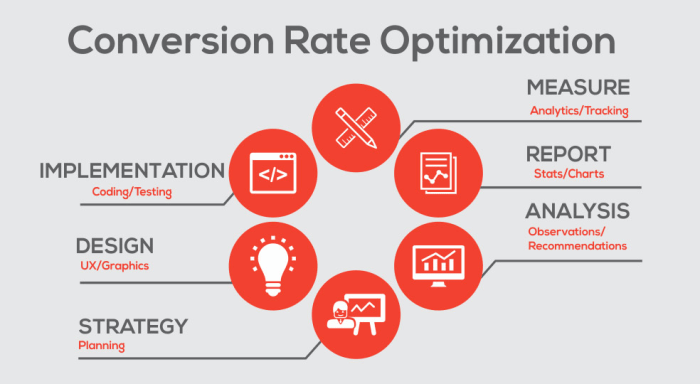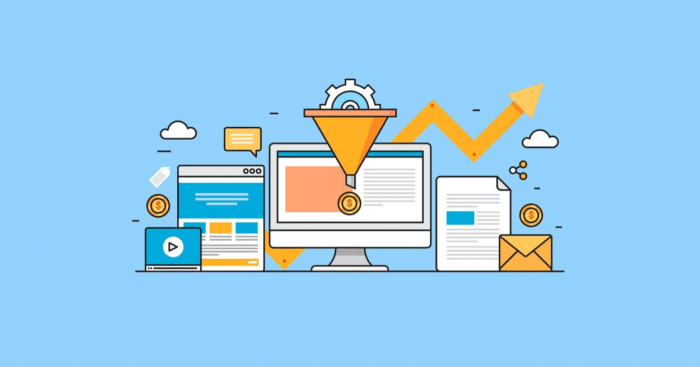Optimizing Conversion Rates dives deep into the world of maximizing business success through effective strategies and techniques. From understanding the importance of conversion rates to exploring key factors that influence them, this topic is a must-read for anyone looking to boost their online presence.
Get ready to uncover the secrets behind successful conversion rate optimization and take your business to the next level.
Understanding Conversion Rates: Optimizing Conversion Rates
In the world of business, conversion rates refer to the percentage of website visitors who take a desired action, such as making a purchase, signing up for a newsletter, or filling out a contact form. It is a crucial metric that helps businesses understand how effective their marketing efforts are in turning visitors into customers.
Optimizing conversion rates is essential for businesses because it directly impacts their bottom line. By increasing the percentage of visitors who convert, companies can generate more revenue without necessarily increasing their marketing budget. This means higher profits and a better return on investment.
Importance of Conversion Rate Optimization
Conversion rate optimization is particularly important in industries where competition is fierce and customer acquisition costs are high. For example, e-commerce businesses heavily rely on conversion rates to drive sales and maximize profits. By optimizing the conversion rate of their online store, they can increase their revenue and stay ahead of competitors.
Similarly, industries like SaaS (Software as a Service) and digital marketing also place a strong emphasis on conversion rate optimization. In these industries, small improvements in conversion rates can lead to significant revenue growth, making it a top priority for businesses looking to scale and succeed in the digital landscape.
Factors Affecting Conversion Rates

When it comes to optimizing conversion rates, there are several factors that can have a significant impact on the success of a website. From website design to targeted marketing strategies, each element plays a crucial role in determining how many visitors are converted into customers.
Website Design and User Experience
Website design and user experience are key factors that can influence conversion rates. A well-designed website that is easy to navigate and visually appealing can help create a positive first impression on visitors. A cluttered or confusing layout, on the other hand, can drive potential customers away. It is important to ensure that the website is optimized for both desktop and mobile devices to provide a seamless user experience across all platforms.
- Responsive design that adapts to different screen sizes
- Clear and concise calls-to-action
- Fast loading times
- Intuitive navigation
- High-quality images and content
“The easier it is for visitors to find what they are looking for, the more likely they are to convert into customers.”
Targeted Marketing
Targeted marketing involves tailoring marketing strategies to specific segments of the audience based on their demographics, behavior, or interests. By focusing on reaching the right people with the right message at the right time, businesses can increase their chances of converting leads into customers.
- Personalized email campaigns
- Retargeting ads to reach visitors who have shown interest
- Social media targeting based on user preferences
- Customized landing pages for different audience segments
- A/B testing to optimize marketing messages
Strategies for Optimizing Conversion Rates

To maximize conversion rates, businesses need to implement effective strategies that resonate with their target audience. A few key strategies include A/B testing, clear call-to-action buttons, and personalized content.
A/B Testing for Improved Conversion Rates
A/B testing involves comparing two versions of a webpage or app to determine which one performs better in terms of conversion rates. By testing different elements such as headlines, images, or button colors, businesses can identify what resonates best with their audience and make data-driven decisions to optimize conversions.
- Run A/B tests on key elements of your website or app, such as landing pages, product pages, or checkout processes.
- Track and analyze metrics like click-through rates, bounce rates, and conversion rates to measure the impact of each test.
- Iterate on successful elements and continue testing to continuously improve conversion rates over time.
The Importance of Clear Call-to-Action Buttons
Clear and compelling call-to-action (CTA) buttons are essential for guiding users towards desired actions on a website or app. A well-designed CTA button should be prominent, action-oriented, and clearly communicate what users can expect when they click on it.
- Use contrasting colors to make CTA buttons stand out on the page and draw users’ attention.
- Keep the text on CTA buttons concise and specific, using action verbs to prompt immediate action.
- Place CTA buttons strategically throughout the page, especially near important content or at the end of a persuasive message.
Significance of Personalized Content in Increasing Conversion Rates
Personalized content tailored to individual user preferences and behaviors can significantly impact conversion rates. By delivering relevant and targeted content to users based on their interactions with a website or app, businesses can create a more engaging and personalized experience that encourages conversions.
- Utilize data analytics and user behavior tracking to understand user preferences and create personalized content recommendations.
- Implement dynamic content that changes based on user interactions, such as recommended products or personalized offers.
- Personalize email marketing campaigns with user-specific content to increase engagement and drive conversions.
Tools and Technologies for Conversion Rate Optimization
In the world of digital marketing, having the right tools and technologies at your disposal can make a significant difference in optimizing conversion rates. Let’s explore some popular options that are widely used in the industry.
Popular Tools for Tracking and Analyzing Conversion Rates, Optimizing Conversion Rates
- Google Analytics: A powerful tool for tracking website traffic, analyzing user behavior, and measuring conversion rates.
- Hotjar: Offers features like heatmaps, user recordings, and surveys to help understand how users interact with your site.
- Crazy Egg: Provides heatmaps, scrollmaps, and click reports to visualize user behavior and identify areas for improvement.
- Optimizely: Allows for A/B testing and personalization to optimize conversions based on user preferences.
Role of Heatmaps and User Recordings
Heatmaps and user recordings play a crucial role in understanding user behavior on a website. Heatmaps visually represent where users click, move their mouse, or spend the most time on a webpage. User recordings capture actual interactions of visitors, allowing marketers to identify pain points, areas of interest, and patterns in user behavior. By analyzing this data, marketers can make informed decisions to optimize the user experience and increase conversions.
CRM Software for Optimizing Conversion Rates
CRM (Customer Relationship Management) software helps businesses manage customer interactions, track leads, and nurture relationships throughout the sales funnel. By integrating CRM software with conversion rate optimization strategies, businesses can personalize marketing efforts, target specific customer segments, and deliver tailored messages to improve conversion rates. CRM data can provide valuable insights into customer behavior, preferences, and pain points, enabling businesses to optimize their conversion strategies effectively.